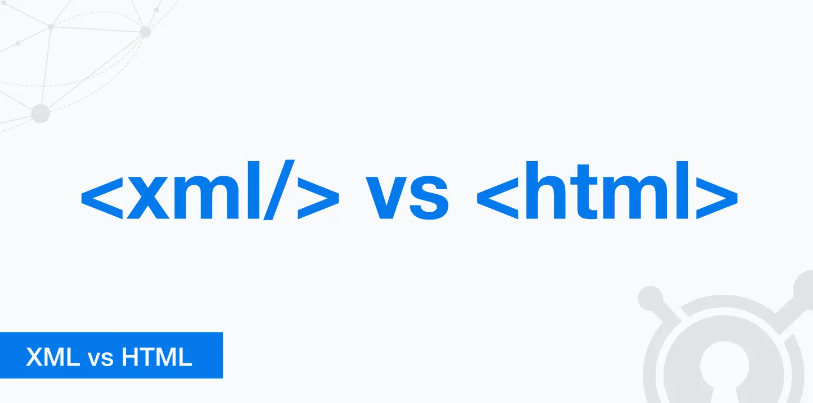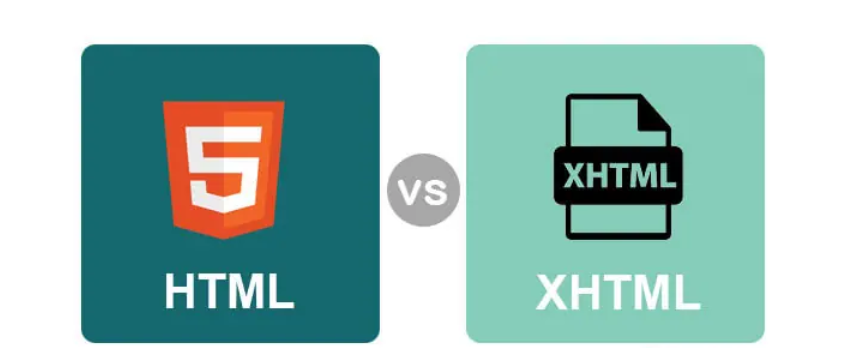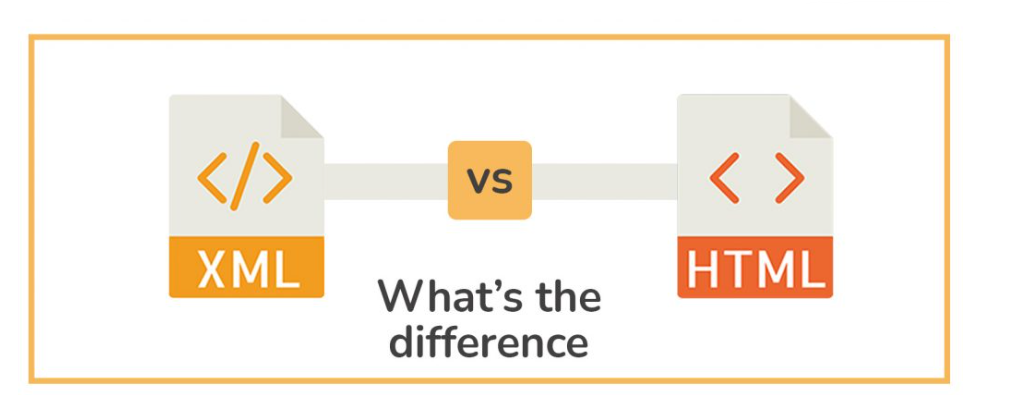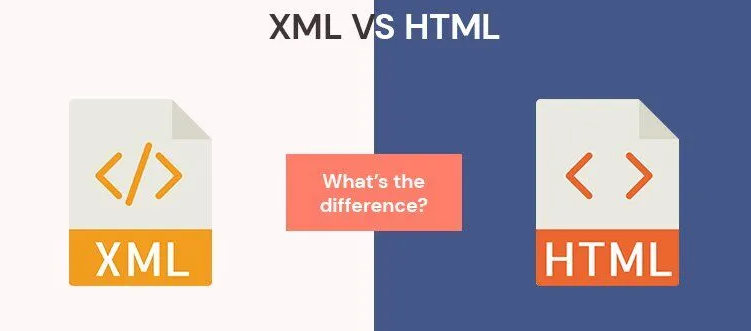When diving into the world of web development and data management, one often encounters two acronyms that seem deceptively similar yet serve fundamentally different purposes: Two formats of markup languages include XML (eXtensible Markup Language) and HTML (Hypertext Markup Language). Knowing the main differences between these two markup languages is necessary for anyone who handles data or works with web technologies. The contrast between XML and HTML forms is quite clear in undergoing comparison because both of them have their own merits, and demerits as well as the scope of implementation. Hence, in this blog post, we will blow the sparks on decoding the major concepts of both XML and HTML tracing their features, usefulness, and differences.
Understanding the Basics of XML and HTML
For fully understanding what separates XML and HTML and how they can be used it is possible to study what aims each markup language is designed to achieve. HTML is the framework of the web pages that browsers read and translate to a format that will be understandable by the user. HTML is mainly concerned with arranging text and images, links, and the like and goes hand-in-hand with CSS and Java scripts in constructing aesthetically pleasing as well as interactive elements in website designs.
In contrast, XML is engineered for data storage and transport. It serves as a flexible way to define, structure, and organize data independently of how it will be presented. Unlike HTML, XML is not concerned with the visual presentation of data but rather with ensuring that data is readable and meaningful both to humans and machines. It enables the developers to deploy new tags according to the different datasets which enhances its flexibility to be used widely.
While HTML’s predefined tags are designed to display content, XML’s custom tags provide context and meaning to the data. We shall see this as the fundamental difference to then allow HTML to be best suited for web development and User interfaces and XML being best suited for data interchange and configuration.
Structural and Syntax Differences Between XML and HTML
HTML and XML differ significantly in structure and syntax. HTML features a predefined set of tags like “, “, and “, which dictate how content should be displayed on web pages. These tags are not case-sensitive, allowing some flexibility, such as the omission of closing tags in certain scenarios. This permissiveness makes HTML forgiving and easier to write but can lead to inconsistent rendering across different browsers.
Conversely, XML mandates a well-formed document structure with strict syntax rules. All tags in XML are case-sensitive, and every opening tag must have a corresponding closing tag. Additionally, XML documents require a single root element to encapsulate the entire content, and all nested tags must be properly structured. This rigorous approach ensures that XML files are machine-readable, facilitating reliable data processing and interchange.
While HTML’s flexible syntax caters to the needs of web page layout and design, XML’s stringent requirements prioritize data integrity and structure. This difference in approach highlights the fundamental distinction between the two: HTML is focused on what is presented to the user and XML is focused as a sound foundation for how data are to be handled or processed.
Use Cases and Applications for XML vs. HTML
HTML is most effective in web development since the user interface on the web page has to be good to catch the user’s attention. HTML provides opportunities to apply CSS for styling and JavaScript for interaction and that helps to develop juicy websites. Front-end development is perhaps its main focus and it is used primarily for building sites, blogs, stores, and Web-based applications.
On the other hand, XML is best suited for data interchange and storage The web, for example, is based on html which is nothing but xml Norfolk (144). The reason why it is popular is because it is used in configuration file formats for document storage, and passing data between systems.
Due to its flexibility, XML is useful in different provinces such as the web services and API where it provides a structured manner of data sharing. XML also has applications in areas like finance, health, telecommunications, and many others to support integration and uniformity in the conversion and transfer of data among the systems.
Also, the popularity of XML results from the fact that the technology enables the creation of domain-specific tags. This makes it especially valuable in those processes where data needs to be transformed into a form that can be readable by a human or in another form understandable for a machine. There are some of them like metadata management, content syndication like RSS feeds, and many more, it also paved the way for creating many large-scale applications within organizations.
More to the point, HTML is built for the specifics of information display and for constructing web experiences on which users can interact, while XML is designed for the details of data exchange and storage.
How XML and HTML Handle Data and Content Presentation
XML and HTML have distinct approaches to managing data and presenting content. HTML is perfect for developing graphic Web sites because it comes with a large number of tags that allow you to format texts, insert films and pictures, and create links. These tags help the developers to guide and arrange, the layout of web pages making them easy to use and beautiful. HTML works seamlessly with CSS to control the visual styling and JavaScript to add interactivity, ensuring a cohesive user experience.
However, XML concentrates on identifying and moving the data while ignoring how they are presented. It employs some user-defined tags in the meaning of semantic tags that give meaning to the contents they hold hence increasing its flexibility. For instance, an XML document may use the tags, and to present a pecuniary transaction without any information concerning how these elements could be presented. This enabled XML to be a very flexible form of data that can be used for various forms and purposes ranging from configuration files to marshaling of data between systems.
Furthermore, due to XML’s ability to separate its data from its presentation its data can be represented in various representations through various technologies including XSLT therefore adding versatility to the technology when it handles a given use. This fundamental difference in dealing with data and rendering it underscores the strength of XML in its domain which is separate from HTML.
Integration with Other Technologies: XML and HTML
HTML’s strength lies in its seamless integration with CSS and JavaScript, allowing developers to create highly interactive and visually compelling web pages. These technologies therefore have facilitated the development of a syntactic structure of the modern web based on HTML forms to support the content, style, and functionality of the usability of the web. This close association with web standards makes HTML to be a valuable asset in front-end development.
As for the shortcomings, it is necessary to mention that XML is not claimed to be the universal language, however, it has a great advantage in the integration with different data-related technologies. Of these one of the most famous is its use with XSLT (eXtensible Stylesheet Language Transformations), which transforms XML data into other formats such as HTML and can thus be used for multiple presentation purposes. Another factor that supports the use of XML in data interchange and storage is the capability of the XML to interface with almost any programming language and API.
Also, XML can interact with databases, web services, and messaging; thus, making the work of passing data easier between different platforms. This feature helps to keep data consistent and interpretable due to its self-describing capability given by the schema definition which is not affected by the technology stack. This makes it preferable for use in practices that involve complicated data structures and transmission such as in XML.
All in all, while HTML is more focused on the creation of the interface that the user sees and interacts with, XML is more focused on the ‘back end’ and data integrity and coordination between disparate systems. This complementary relationship points to the fact most languages are specialized which means that each language is good at what it is designed to do.
Validation and Error Handling in XML vs. HTML
XML and HTML take markedly different approaches to validation and error handling, which impacts their reliability and user experience. XML is built on a foundation of strict syntax rules and validation mechanisms. They rely on Document Type Definitions (DTDs) and XML Schemas that contain statements of the structure and constraints of documents.
This helps ensure that any XML documents are in form and structure that meets some form of standardized format hence making the processing of data more uniform and accurate. If an XML document does not conform to these conditions, it is deemed non-well-formed and the error must be fixed to parse the document.
HTML, on the other hand, provides less strict rules as to the structure of the Web document. Browsers interpret HTML and browsers are quite tolerant and can even display an HTML page that is not ‘well-formed’. This flexibility helps the developers to be more free in developing products for fast and aggressive release for the market.
However, this permissiveness causes a lack of uniformity and website display may be seriously inconsistent in different browsers or even different devices. There are tools to check the validity of HTML code, but what these tools offer are not rules that need to be followed but rather guidelines which allow browsers to determine how to handle errors on their own.
This fundamental difference goes to prove why and how each of these markup language prioritize different aspects of their respective roles – While XML is best used and acknowledged for its ability to provide dependable data integrity, HTML is best used and acknowledged for its ability to facilitate easy construction of Web page.
Future Trends and Developments for XML and HTML
Both XML and HTML are evolving to meet the demands of modern technology. HTML5 is the newest version of HTML with improvements over the previous one in the areas of new forms of the semantic web, multi-media support in HTML, and better APIs. These developmental enhancements put into practice enable developers to create more progressive and interesting experiences across HTTP, further making HTML5 as a very important component of modern website.
XML still has its relevance more so in areas that may demand precision on the structure of data as well as its security. Although today JSON could be considered lightweight and friendly to JavaScript, situations, demanding data interchange and enterprise-level apps still employ XML for its solidity. Signs of continued development of XML are long-term XML-based Web services and configuration management systems among others.
More specifically, regarding future developments, HTML is likely going to expand on the feature set to better support what are modern web applications like PWAs as well as WebAssembly interoperability. On the other hand, XML will continue to dominate in areas that require the efficient and accurate processing of data as well as interoperation while co-existing with other data formats. It is for this reason that XML and HTML have evolved at the same time and are two media that are complementary and mutually complementary, in the dynamic universe of web and data applications.



